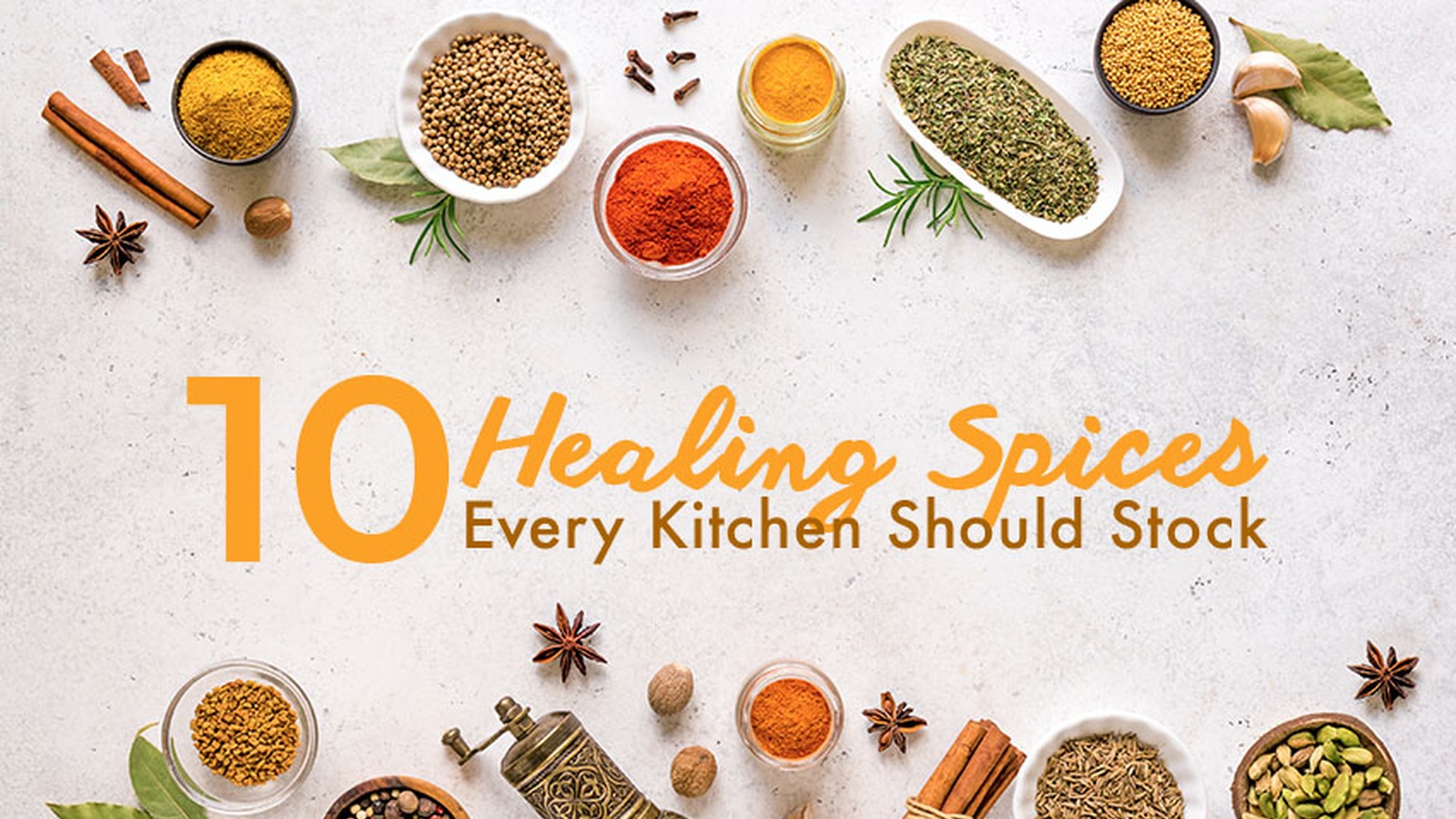10 Healing Spices Every Kitchen Should Stock
One of the core principles of Food Matters is that food is medicine, but this goes much further than just your main ingredients. What spices you choose to add to your dish can make a world of difference as spices have many powerful healing benefits.
With herbs and spices being the key to healing for thousands of years, which healing spices are best kept close at hand in your kitchen?! Here is our list of the top 10 healing spices you should have well-stocked at home!
1. Turmeric
Why it’s good for you:
Turmeric can help reduce inflammation, reduce the risk of arthritis, Alzheimer’s, and heart disease. One study in healthy middle-aged volunteers showed that taking 80mg of curcumin, a component of turmeric, a day for four weeks reduced markers of inflammation and oxidative stress.
How to eat it:
Turmeric highlights teas, juices and smoothies, it is great in a healing nut milk latte, as a dip that you can put on practically anything, and one of our personal favorites is in scrambled eggs.
2. Cumin
Why it’s good for you:
Cumin is a delicious spice that can help you lose weight and increase your metabolism. It also aids in relieving congestion and indigestion.
How to take it:
You can purchase cumin as a powder, but we love buying cumin seeds whole and grinding them in a mortar and pestle. There’s something wonderful about smelling freshly ground cumin and knowing how much good it will do for your body when you consume it.
Cumin is a staple in most curries and Indian dishes, but is also great in scrambled eggs and healing teas.
3. Cayenne
Why it’s good for you:
Cayenne is yet another powerful spice that has been used medicinally for thousands of years. Made from the cayenne pepper, the key ingredient in this spice, capsaicin, boasts many health benefits. Capsaicin is known to help boost the metabolism, lower blood pressure by relaxing the vessels, and even helps with osteoarthritis.
How to eat it:
Though you can purchase capsaicin creams, it’s much easier to add a sprinkle of cayenne to your food to receive the benefits, and because this is such a powerful spice, it doesn’t take much! Just give this Metabolism-Igniting Pumpkin Juice a try - it only takes ¼ tsp of cayenne to make a world of difference.
4. Paprika
Why it’s good for you:
Paprika is a pepper-based spice full of antioxidants that helps fight a range of diseases due largely to its ability to fight oxidative stress.
Paprika helps reduce inflammation and may be able to prevent and fight autoimmune conditions and some cancers.
How to eat it:
Paprika is most popularly known as a key ingredient in Hungary’s signature dish, the goulash. We also love to eat paprika in healthy snacks, and this recipe for Smoked Paprika Rosemary Almonds is not only delicious but makes for a great gift!
5. Garlic
Why it’s good for you:
Garlic is an antioxidant, antibiotic, and an aphrodisiac… despite the garlic breath, it can create! Garlic boosts the immune system, helps destroy free radicals and helps prevent heart disease by reducing atherosclerosis or hardening of the arteries, lowering cholesterol and lowering blood pressure.
How to eat it:
For the greatest health benefits, after you chop or crush it, leave your garlic to sit for 5 minutes before cooking or eating to allow the health-promoting allicin to form. Garlic can be eaten raw or cooked in a variety of ways including pan-fried in a stir fry, included in your mash potato, or roasted and eaten whole. We particularly love making tahini garlic sauce for falafels… or anything really!
6. Black Pepper
Why it’s good for you:
Not just a great addition to any meal, black pepper has great antidepressant properties as well as being an antioxidant with antimicrobial potential and gastro-protective modules. Additionally, black pepper activates free-radical scavenging and is also thought to be helpful in chemoprevention and controlling the progression of tumor growth.
As if that wasn’t enough for this humble table seasoning, black pepper is also attributed to improving cognitive brain function, boosting nutrient absorption, and improving gastrointestinal functionality.
How to eat it:
Black pepper is complementary to most savory dishes, with most recipes suggesting a pinch of this healing spice to finish a dish. We incorporate pepper into our dips, dressings, salads, snacks, and dinners, preferring freshly ground black peppercorns.
7. Ginger
Why it’s good for you:
In Ayurvedic medicine, ginger is known as a ‘natural medicine chest’ because of its time-tested digestion-friendly properties, as well as its ability to improve the absorption of essential nutrients in the body, clearing sinuses and congestion, relieving nausea, and assisting with joint pain due to its anti-inflammatory properties.
How to eat it:
Ginger has a multitude of ways to be enjoyed, from tea to juice to baked goods, even pickled meal accompaniments, sweet treats, and in a stir fry, there’s plenty of options to get the health benefits from ginger. We find drinking ginger with water or in a juice a great way to start each day.
8. Cinnamon
Why it’s good for you:
Sweet, delicious cinnamon is a spice you can enjoy guilt-free as it is a powerful antioxidant and can have a positive effect on your blood sugar levels, digestion, and immune system, as well as reducing blood cholesterol. When taken in strong doses, cinnamon has been known to reduce the risk of diabetes, cancer, and neurodegenerative diseases.
How to eat it:
Cinnamon can be enjoyed with sweet and savory dishes as well as in hot and cold beverages. We love Cinnamon Clove Hot Chocolate that warms the belly, satisfies the taste buds, and does great things for our health!
9. Cloves
Why it’s good for you:
Cloves are great for curing cold-natured problems that affect the central nervous system as well as aiding digestion through increasing heat in the stomach and liver. Consuming cloves can aid in functions of the throat and speech, and strangely enough, cloves can help reduce hiccups!
How to eat it:
For the hiccup cure, warm up a few cloves in a spoonful of butter or ghee and drink it. For other ailments, or to enjoy the strong flavor notes, try adding cloves to smoothies, hot chocolates, or give our Beet Kavass with Orange and Cloves a try!
10. Nutmeg
Why it’s good for you:
Nutmeg has been used for centuries to alleviate pain, gastrointestinal disorders, heal skin wounds and infections, and it has a great calming effect. It’s also been reported as an aphrodisiac. Caution must be taken when consuming nutmeg, as too much can lead to unpleasant hallucinogenic effects.
How to eat it:
You only need a little ground nutmeg as this spice is very flavorsome and its benefits can be found in just a sprinkle. Nutmeg is often used in festive baking and egg-nog drinks, but nutmeg can be used to spice up a number of food and beverages with a sprinkling on your fruits and vegetables. We enjoy the flavor and impact of nutmeg in this fruity no-bake nut cake.
Now you just need the inspiration to use them.
Discover how to eat your medicine to heal your gut, eliminate bloating, skin issues and hair loss as I share seven nutrition principles in this free masterclass. Running for a limited time only.










